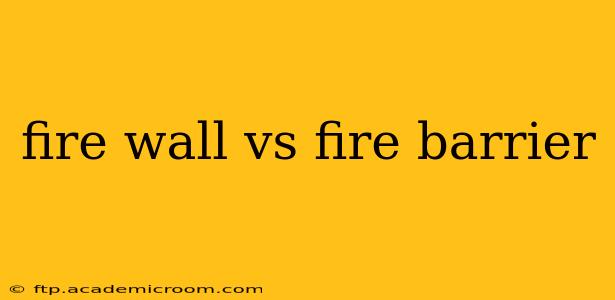Fire safety is paramount in any building, and understanding the distinctions between firewalls and fire barriers is crucial for ensuring adequate protection. While both aim to contain fires, their design, purpose, and applications differ significantly. This article will delve into the core differences between firewalls and fire barriers, addressing common questions and clarifying their roles in fire safety.
What is a Firewall?
A firewall is a robust, fire-resistant wall designed to prevent the spread of fire within a building or between adjacent buildings. It's a structural element, typically constructed from masonry (brick, concrete block) or reinforced concrete, and built to withstand intense heat and flames for an extended period. Firewalls are designed to compartmentalize a building, limiting the extent of a fire's impact and providing crucial time for evacuation and firefighting efforts. They're often thicker and more substantial than fire barriers. Key characteristics include:
- High fire resistance rating: Measured in hours, indicating how long the wall can withstand fire exposure without failure. Ratings typically range from 1 hour to 4 hours or more.
- Independent foundation: Firewalls often have their own independent foundation, ensuring they remain stable even if the surrounding structure collapses.
- Extensive penetration protection: Penetrations like pipes, conduits, and ducts passing through the firewall are carefully sealed and protected to prevent fire spread.
- Used in larger buildings and multi-unit complexes: They're essential in larger buildings to create separate fire zones, enhancing safety for occupants and firefighters.
What is a Fire Barrier?
A fire barrier is a fire-resistant assembly, less robust than a firewall, designed to restrict the spread of fire and smoke within a building. It could be a wall, floor, ceiling, or even a door assembly. Fire barriers are often constructed from various materials, including drywall, gypsum board, and specialized fire-rated assemblies. They serve to isolate specific areas or create fire-rated compartments within a building, but they don't have the same structural integrity as firewalls. Key characteristics include:
- Lower fire resistance rating: Typically rated for shorter durations than firewalls, often 1 hour or less.
- May not have an independent foundation: They are typically integrated into the building's overall structure.
- Simpler penetration protection: While penetration protection is still necessary, it's often less complex than that required for firewalls.
- Used for compartmentalization within a building: They are commonly used to separate different occupancy types, hazardous areas, or to meet specific building code requirements.
What are the Key Differences Between Firewalls and Fire Barriers?
The table below summarizes the key differences:
| Feature | Firewall | Fire Barrier |
|---|---|---|
| Purpose | Prevent fire spread between buildings or large fire zones within a building | Restrict fire and smoke spread within a building |
| Construction | Typically masonry or reinforced concrete | Various materials, including drywall, gypsum board, etc. |
| Fire Resistance Rating | Higher (often 2-4 hours or more) | Lower (often 1 hour or less) |
| Structural Integrity | High; designed to remain stable during a fire | Lower; integrated into the overall structure |
| Foundation | Often independent | Typically integrated with the building’s foundation |
| Penetration Protection | More extensive and complex | Less extensive and complex |
How are Firewalls and Fire Barriers Specified?
Both firewalls and fire barriers are specified and regulated by building codes. These codes define the required fire resistance ratings, construction materials, and installation methods. Local building officials and fire marshals ensure that these requirements are met during construction and inspections.
What are some common applications of firewalls and fire barriers?
Firewalls:
- Separating buildings in a multi-building complex.
- Dividing large buildings into smaller fire zones.
- Protecting critical infrastructure within a facility.
Fire Barriers:
- Separating different occupancy types within a building (e.g., apartments, commercial spaces).
- Enclosing hazardous areas like mechanical rooms or storage areas.
- Creating fire-rated shafts for elevators or stairwells.
How do I choose between a firewall and a fire barrier?
The choice between a firewall and a fire barrier depends entirely on the specific needs of the building and the requirements of the applicable building codes. Consulting with a qualified fire protection engineer or architect is essential to determine the appropriate level of fire protection. They will assess the building's layout, occupancy, and risk factors to recommend the best solution.
This comprehensive guide clarifies the essential differences between firewalls and fire barriers. Remember, understanding these differences is vital for ensuring the safety and security of any building. Always consult with qualified professionals to ensure proper design, installation, and compliance with building codes.
